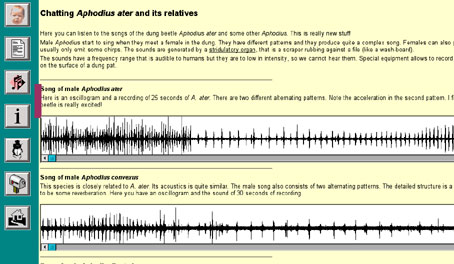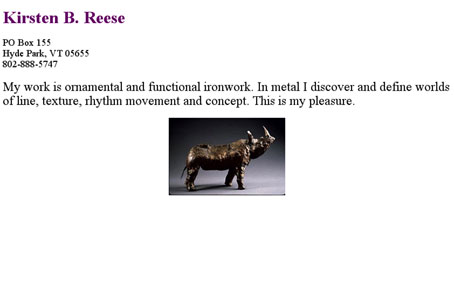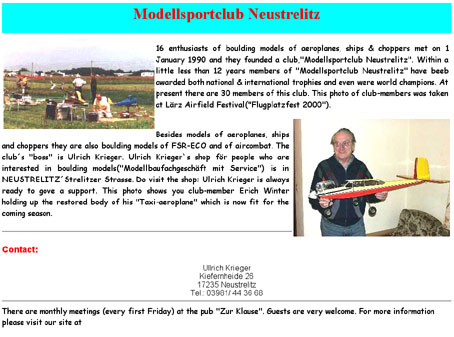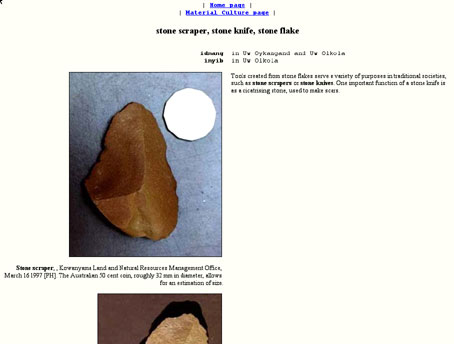<<
Concept inyib by Kirsten Reese
for nine instruments, live-electronics, 3 CD players, 15 speakers
software live-electronics: Thomas Seelig
first performance: ensemble zeitkratzer, Podewil Berlin, 6 July 2002
Concept and performance set-up
In the performance the nine musicians are placed in sub-groups of three players. Each sub-group is connected with one computer. Each musician has his own live-electronic effects path and his own individual loudspeaker which only amplifies his processed instrumental sounds. The sounds are played from a score. They are routed to a selection of around 60 effects presets customized for this piece by the composer. The effects - programmed in MAX/MSP by Thomas Seelig - are recalled automatically from the computer via a timeline.
At the beginning of the composition process, some of the musicians from the ensemble Zeitkratzer were asked to record a list of sounds. The list was comprised of sixteen instrumental sounds: low, middle and high tones in several variations and sounds using noise and/or generated by unconventional playing techniques. However, the exact tone or sound (that is the exact register, duration, dynamic, attack) etc. to be recorded by each individual member of the ensemble was not prescribed.
The list of sounds that the musicians recorded included environmental sounds from the every-day life of each musician. These sounds were to come from either sounds generated from daily domestic activities, sounds from one’s local surroundings, and sounds from media.
In performance, alongside the nine individual loudspeakers for each player, a further six loudspeakers are positioned within the performance space which project these envrionmental sounds. The environmental sounds were processed prior to performance and mixed with a further catalogue of sounds found on the internet by using each musician’s name as an internet search term.
Websites of the musicians’ ‚internet alter egos’ are displayed on the three computer screens used in the piece and these images change in concurrence with the effect presets.
The audience is free to move around the performance space.
Background
inyib picks up on aspects of internet and web music: one starting point for the composition was to think about what 'internet music' might idealy be: should it’s characteristics be defined by processes -- networking, communication, participation, up- and downloading of sounds, exchange of soundfiles – or by the sounding results of these processes? Of existing web projects there were two kinds that interested me: those that search and assemble soundfiles through random selection; and those that function as a kind of 'field recording' archive, to which anyone can contribute by uploading his or her sounds.
I decided not to attempt to compose 'internet music', but instead to work with the aspects behind the concept of the world wide web - through having the sounds recorded by the musicians in various places, the visual integration of websites in the piece as well as using the net to find some of the raw sound materials for the work.
A further starting point for the piece was to split the Zeitkratzer ensemble into loose groups and to have the music to sound from many small loudspeakers dispersed within the performance space.
Through the division of the performance space, the fact that the musicians had sent me their personal sounds, and via the visual presentation of the musicians' internet-alter-egos, the musicians should also come across as individual subjectivities. The instrumental sounds have a personal inflection without being ''expressive'' i.e. without any self-projection attached in their re-production (as it is often the case when, for example, a composition leaves space for free improvisation). Furthermore, because the sounds were selected from a given list and were a maximum of one minute in length, they were already incontinous and relatively ‚neutral’ with regards to a respective content.
The environmental sounds sent to me by the musicians are as equally ‚unspectacular’ as the instrumental sounds:
everyday noise: The series of sound traces that every human being leaves behind in their daily work and chores are similar. The quiet business of moving around in one’s appartment, working in the kitchen and at one’s desk all have a rhythmical element, an 'irregular regularity' that interest me musically. These sounds have an intimacy (e.g. the sound of brushing one's teeth or breathing sounds in the background) similar to that feeling of eavesdropping one gets listening to sounds from the internet.
environmental sounds from the local sorroundings: here the horizon is extended from the private into public space. The sound material has more content and is ‚busier’ but nonetheless also relatively unspectacular. Regarding the actual sites where the musicians recorded the sounds there were coincidences: supermarket, café, street, forest -- each person moves in similar sound environments, but there are also particular shades, variations of similarity (e.g. the language changes according to the country where a recording was made -- one musician is from Italy, one from Austria etc.).
media clips: cuttings from various forms of electronic media were used to convince us 'that there is still something else out there’. The mediaclips that Zeitkratzer recorded were more or less randomly selected (but not in the strict Cageian sense of chance: see below). They were, as with the other two categories of environmental sounds, ''not meaningful'' (among the recordings there were news clips on the Middle East and a discussion with an EU official about the Pisa education study but also bits of talkshows, mobile phone messages on traffic jams from the German national automobile association, TV-movie sequences etc.). In his piece Automatic Writing (Lovely Music CD 1002) the American composer Robert Ashley is concerned with ''involuntary speech'' as it is performed by sufferers of Tourette's Syndrome. In this sense, each media clip has an involuntary -- unintended -- speech in itself ( in the aforementioned examples this would then mean: traffic jam report stands for immanent traffic chaos, a quarrel of a couple in a TV- Movie for domestic violence, injust education opportunities, etc.)
The ‚meaningfulness’ of spoken material nevertheless rather remains in the background, because the environmental sounds and media clips were electronically processed such that during performance only some parts of the material is decodable. Futhermore, because of fifteen channels running simultaneously, the piece is sometimes very dense. What I aimed for was a feeling that there are layers, an undercurrent of associations and connections beneath the surface of the work, and that the listener can 'log-in' to these strata and decode and make connections between seemingly incongruent associations.
Composition / sound processing / effects
The processing of sounds is various (e.g. one can sometimes understand practically all of the content of speech samples, sometimes one can only hear the modulation of the voice as the resultant sound). The type of effects employed underlines the spatial nature of a network: repetitions/ loops and delays emerge and disappear; reverberation effects artificially expand the auditive space. The instrumental voices are also charged with their own 'resonance' via live electronic processing. The instruments often play short samples of discrete sounds which are then repeated with progressively changing effects. There are also delays that, via the loudspeaker, act as answers to the instrumental statements. Resonance happens also in the performance space between the instruments and the loudspeakers – the listener can make a connection, although there is no technical connection.
Internetsounds
Alongside the mediaclips that Zeitkratzer sent to me, I used soundfiles from the internet, the files themselves being selected using the names of musicians in the group as key search words. Because the possibilities of key word searches for sound in search engines are still limited (one usually finds pop songs which I didn't want to use), the search results were particularly erratic (e.g. sounds of beetles whose vocal instruments are called 'scrapers') up until the context becomes incomprehensible (out of a search on the name ''Luca'' appeared a site wih radiosignals from a so-called 'counting station' operated by the US army near Frankfurt: a female voice recites strange orderings of numbers broken occasionally with small electronic beeps).
Chance/ coincidence
Chance plays an important role in inyib in so far as there is an ambivalence between the meaning of sounds -- 'eveything speaks' -- and the random selection of the sounds themselves. (This however is only an apparent contradiction: there are cultures where the term 'chance' does not exist because everything is seen to depend upon everything else.) I think of 'chance' not in the strict Cageian sense which has become so important in contemporary music but more in the Ashley sense of 'coincidence'.

| 
Visual: Websites of Alter Egos
I wanted the audience to be able to move freely throughout the space during the performance of inyib to search for their own listening space as well as to have the possibility to look over the shoulders of the musicians, as if treading into an intimate zone. The audience can also approach the computers -- the imaginary command center of the piece -- and view the monitors.
Web sites of ‚alter egos’ of the musicians found on the internet are displayed on the computer monitors: I typed the names of the musicians into a search engine but only used sites that were not about the musicians but about people with the same name. Subsequently, random and illogical connections again opened up an otherwise limited horizon of who we are and what we occupy ourselves with, to the --perhaps equally restricted – world of other people and their activities (e.g. the American sculptor Kirsten Reese or the politically engaged sociologist Reinhold Friedl in Hamburg). The banal becomes meaningful, and creates associations.
| 
| 
The websites that I hit upon with this game of name exchange remained nonetheless mostly within the circle of western culture. However, searching with the term ‚scraper’ (from Zeitkratzer - Timescraper) was something else: ‚scraper’ is (along with the aforementioned vocal tool of beetles) a generic term for a stone age tool that is mentioned in various websites of archeological content throughout the world. The associations -- hammering, scratching, beating: bringing out irregular regular noises -- sat well with the composition. Then I hit on 'inyib' which is the North Australian aborginal word for 'scraper'.
Inversely, when I searched under 'inyib' using the various available search engines on the web I either didn't find anything or, as was the case with one engine, I only found three URLs: one website ''URL not found'', the internet site with the north Australian Dictionary were I originally found the word 'inyib'; and a photo from an old synthesizer from the 1960's, without any descriptive text of context...
| 
| 
|






